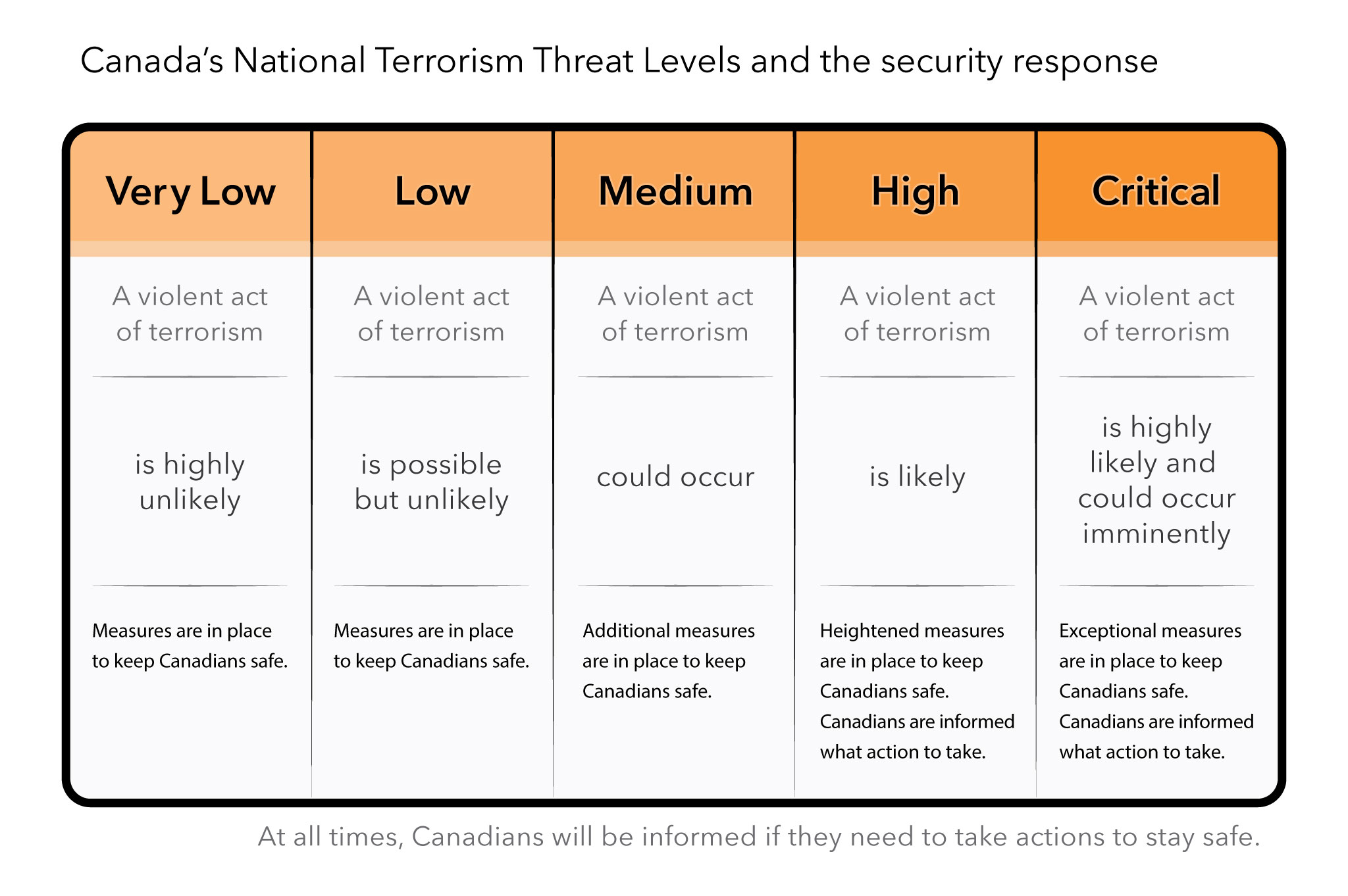Canada's National Terrorism Threat Levels
The ever-changing nature of the threat environment means that Canada must remain continually vigilant.
Canada's National Terrorism Threat Level is a tool that government officials, including law enforcement agencies, may use to identify risks and vulnerabilities from threats, and in turn determine what responses may be needed to prevent or mitigate a violent act of terrorism in Canada. It also helps ensure a common understanding of the general terrorist threat to Canada.
Current Threat Level
Canada's current level is Medium, meaning that a violent act of terrorism could occur, and has been at this level since October 2014.
Threat level assessments are conducted at a minimum of every four months, or more frequently if needed.

Image description
Canada's national terrorism threat levels and the security response.
- Very low: A violent act of terrorism is highly unlikely. Measures are in place to keep Canadians safe.
- Low: A violent act of terrorism is possible but unlikely. Measures are in place to keep Canadians safe.
- Medium: a violent act of terrorism could occur. Additional measures are in place to keep Canadians safe.
- High: a violent act of terrorism is likely. Heightened measures are in place to keep Canadians safe. Canadians are informed what action to take.
- Critical: a violent act of terrorism is highly likely and could occur imminently. Exceptional measures are in place to keep Canadians safe. Canadians are informed what action to take.
At all times, Canadians will be informed if they need to take actions to stay safe.
What are Canada's National Terrorism Threat Levels?
Canada's National Terrorism Threat Levels represent the likelihood of a violent act of terrorism occurring in Canada, based on information and intelligenceFootnote 1.
What does the threat level mean for you?
Canada's threat levels do not require specific responses from the public.
Should any threat or incident warrant specific actions from Canadians, the Government will communicate this information through public statements.
Regardless of threat level, Canadians should always remain alert to the danger of terrorism and report any suspicious activity to the National Security Tip Line (1-800-420-5805) or by contacting the police in their community.
How does the National Terrorism Threat Level help protect Canadians?
Threat level information is shared with the Canadian security and intelligence community, provincial and municipal emergency authorities, first responders and relevant stakeholders so they can identify risks and vulnerabilities from threats and determine what measures to put in place to prevent or mitigate a violent act of terrorism.
Potential threats are continuously monitored by Canada's intelligence, security and law enforcement agencies, with robust measures in place to address them.
How is the level determined and what would cause it to go up or down?
Canada's Integrated Threat Assessment Centre (ITAC) is an independent, expert federal body responsible for assessing terrorism threats to Canada and Canadian interests globally. ITAC constantly examines the terrorism threat environment, relying on information and intelligence from Canadian and international security partners. ITAC provides objective, expert recommendations about the threat level.
Threat level assessments are conducted at a minimum of every four months, or more frequently if needed.
When making a determination on the National Terrorism Threat Level, ITAC considers several factors, including past trends and current intelligence on the known intentions, capabilities and opportunities for terrorism entities to conduct attacks. Changes in any of these factors could result in an either an increase or decrease of the national terrorism threat level.
What security measures would be taken at the high and critical levels?
In the event of an increase of the threat level to high or critical, a range of security measures could be taken, depending on the severity and nature of the threat.
Measures could include things Canadians wouldn't see, such as increased internal information-sharing, as well as some visible measures, such as an increase in physical security at public venues.
In many cases specific security measures would not be announced publicly, as this could compromise efforts.
What are the terrorist threats that Canada faces?
For an overview of the terrorist threat to Canada and the Government's counter-terrorism efforts, please read the Public Reports on the Terrorist Threat to Canada.
Questions and Answers on Canada's National Terrorism Threat Levels